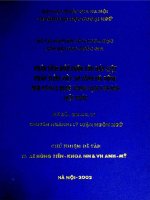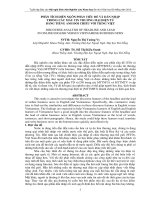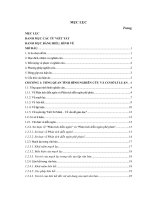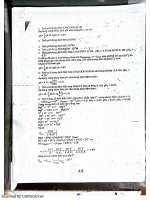Đề thi 20% phân tích diễn ngôn số 1
Bạn đang xem bản rút gọn của tài liệu. Xem và tải ngay bản đầy đủ của tài liệu tại đây (104.12 KB, 6 trang )
HANOI OPEN UNIVERSITY
MID -TERM TEST ON DISCOURSE ANALYSIS
FOR STUDENTS OF ENGLISH (No 1)
Subject Code: EN44
Full name: ………………………………...............
Date of birth: ………………………………...........
Group: …………………………………….............
BÀI GIẢI FULL
I. Prove that the following passage is a written text.
Juvenile Crime in the 19th Century
Novels such as Oliver Twist have made Victorian child-thieves familiar to
us, but to what extent did juvenile crime actually, exist in the 19th century?
Drawing on contemporary accounts and printed ephemera, Dr Matthew White
uncovers the facts behind the fiction. The success ofOliver Twist owes much to the
biting satire and keen social observations contained within its pages. The misery of
workhouses, the morally corrosive effects of poverty and the degradation of life in
Victorian slums all received Dickens’s close attention. The novel’s prominent
theme though is criminality, witnessed most vividly in the activities of Fagin’s
gang of nimble-fingered child-thieves. But how realistic was Dickens’s portrayal of
criminality among Victorian boys and girls?
Although youth crime had been a concern since the 1700s, a decline in formal
apprenticeships and the disruptive effects of industrialisation on family life after
1800 did much to create fears among the general public about the activities of
criminal gangs of boys and girls in London and elsewhere.
Sensational stories of crime and violence filled the pages of the popular
press after 1800 with details of juvenile crime appearing in newspapers, broadsides
and pamphlets. The activities of so-called ‘lads-men’ were regularly reported.
These were criminal bosses who supposedly trained young boys to steal and then
1
later sold the stolen goods they received from them. Thomas Duggin, for example,
was an infamous ‘thief-trainer’ who worked in London’s notorious St Giles slum in
1817, and as late as 1855 The Times newspaper reported the activities of Charles
King, a man who ran a gang of professional pick-pockets. Among King’s gang was
a 13-year-old boy named John Reeves, who stole over £100 worth of property in
one week alone. Similarly, Isaac ‘Ikey’ Solomon was a well-known receiver of
stolen goods in the 1810s and 1820s who was arrested several times, and on one
occasion escaped from custody. Solomon gained notoriety for being a trainer of
young thieves and was for some time (incorrectly) considered to be the inspiration
behind Dickens’s character of Fagin owing to his similar Jewish heritage.
‘Flash-houses’ also received regular attention from the police during the first
half of the century. These were pubs or lodging houses where stolen property was
‘fenced’, and was considered by the police and magistrates to be ‘nurseries of
crime’. One report in 1817 described flash-houses as containing ‘distinct parties or
gangs’ of young boys, while later in 1837 a police witness recalled how one lodging
house in London had ‘20 boys and ten girls under the age of 16’ living together,
most of whom were ‘encouraged in picking pockets’ by their ‘captain’.
The provided passage is a written text. It consists of coherent sentences and paragraphs that
convey information and ideas related to the topic of juvenile crime in the 19th century. The
text discusses the portrayal of juvenile crime in Victorian novels, particularly focusing on
Charles Dickens's Oliver Twist, and examines the extent of juvenile crime during that
historical period.
The passage is structured with headings and subheadings, indicating different sections and
points being addressed. Additionally, the text uses formal language, specific terminology
such as "child-thieves," "criminal gangs," "flash-houses," "juveniles," and "police witness,"
and references to historical events, all of which contribute to its written form.
Overall, the passage exhibits the characteristics of a written text, presenting coherent and
organized information, making it evident that it is a written piece of content.
II. Find grammatical and lexical cohesive devices employed in this text.
2
................................................................................................................................................ ..
..............................................................................................................................................
Grammatical Cohesive Devices:
1. Pronouns: "us," "we," "its," "his," "them," "who," "their," "it," "he," "them," "which," "whose,"
"these," "those." These pronouns refer back to previously mentioned nouns or concepts, aiding in
maintaining continuity and connecting ideas.
2. Demonstrative Pronouns: "this," "these," "that." These pronouns point to specific nouns or
ideas previously mentioned, helping to clarify references.
3. Connectors: "such as," "but," "although," "and," "while," "also," "similarly," "however." These
connectors link ideas and sentences, indicating relationships and transitions between different
pieces of information.
4. Subordinating Conjunctions: "although," "while," "when," "because," "since." These
conjunctions introduce dependent clauses that provide additional information or reasons related
to the main clause.
5. Passive Voice: "was made," "were regularly reported," "was arrested," "was considered," "was
described," "were living," "were encouraged." The passive voice is used to emphasize the action
or to focus on the subject receiving the action.
Lexical Cohesive Devices:
1. Synonyms and Repetition: "criminality" and "crime," "youth crime" and "juvenile crime,"
"boys and girls" and "young boys," "stolen goods" and "property," "gangs" and "parties,"
"lodging houses" and "flash-houses." The use of synonyms and repetition strengthens the
coherence and clarifies the meanings of specific terms.
2. Specific Terminology: The text employs specialized terms such as "formal apprenticeships,"
"industrialisation," "criminal bosses," "juvenile crime," "fenced," "nurseries of crime," "police
witness," "captain," etc., to maintain precision and clarity in the content.
3
3. Descriptive Language: "sensational stories," "activities," "notorious," "infamous," "wellknown," "similar," "flash-houses," "lodging house," "picking pockets," "captain." These
descriptive phrases add vividness and specificity to the discussion.
4. Time References: "after 1800," "in 1817," "as late as 1855," "during the first half of the
century," "later in 1837." These references provide chronological order and help organize the
information.
Overall, the text employs a range of grammatical and lexical cohesive devices to link ideas,
establish coherence, and ensure smooth transitions between different pieces of information.
4
................................................................................................................................................ ..
..............................................................................................................................................
................................................................................................................................................
..........
III. Translate the text into Vietnamese.
Tội phạm thanh thiếu niên trong thế kỷ 19
Như các tiểu thuyết như Oliver Twist đã làm cho các đứa trẻ trộm đạo của thời kỳ
Victoria quen thuộc với chúng ta, nhưng mức độ nào tội phạm thanh thiếu niên thực sự
tồn tại trong thế kỷ 19? Dựa trên các báo cáo đương thời và các tài liệu in ấn, Tiến sĩ
Matthew White khám phá những sự thật đằng sau hư cấu. Sự thành công của Oliver
Twist nợ rất nhiều cho sự châm biếm sắc bén và quan sát xã hội sắc bén được chứa trong
các trang của nó. Nhục nhã của các nhà làm việc, tác động ăn mòn đạo đức của nghèo đói
và sự suy giảm cuộc sống trong các khu ổ chuột của thời kỳ Victoria đều nhận được sự
chú ý đặc biệt của Dickens. Tuy nhiên, chủ đề nổi bật của cuốn tiểu thuyết là tội phạm,
được thấy rõ nhất trong hoạt động của băng nhóm trẻ em tinh ranh của Fagin. Nhưng việc
Dickens miêu tả về tội phạm giữa các cậu bé và cô gái của thời kỳ Victoria có thực sự
hay khơng?
Mặc dù tội phạm thanh thiếu niên đã là một vấn đề từ thập kỷ 1700, sự suy giảm trong
việc học việc chính thức và tác động gây rối của cơng nghiệp hóa đối với cuộc sống gia
đình sau năm 1800 đã đóng góp rất nhiều vào việc tạo ra sự lo sợ trong cơng chúng nói
chung về hoạt động của các băng nhóm tội phạm của các cậu bé và cô gái tại Luân Đôn
và nơi khác.
Những câu chuyện gây chấn động về tội phạm và bạo lực đã lấp đầy các trang của báo chí
phổ biến sau năm 1800 với chi tiết về tội phạm thanh thiếu niên xuất hiện trong các báo,
tờ rơi và cuốn sách nhỏ. Các hoạt động của những người được gọi là 'lads-men' thường
xuyên được báo cáo. Đây là các ông trùm tội phạm, được cho là đào tạo các cậu bé trẻ để
trộm cắp và sau đó bán các hàng hóa trộm đạt được từ họ. Thomas Duggin, ví dụ, đã từng
là một 'huấn luyện viên trộm' nổi tiếng, làm việc tại khu ổ chuột St Giles của Luân Đôn
vào năm 1817, và ngay cả vào năm 1855, báo The Times đã báo cáo về hoạt động của
Charles King, một người điều hành một băng nhóm móc túi chuyên nghiệp. Trong băng
nhóm của King, có một cậu bé 13 tuổi tên là John Reeves, đã trộm hơn 100 bảng Anh
5
................................................................................................................................................ ..
..............................................................................................................................................
trong một tuần duy nhất. Tương tự, Isaac 'Ikey' Solomon là người tiếp nhận hàng hóa
trộm đạt danh tiếng vào thập kỷ 1810 và 1820 và đã bị bắt giữ nhiều lần, và một lần thoát
khỏi tù. Solomon nổi tiếng vì là người huấn luyện trẻ trộm và một thời gian (sai) bị xem
là nguồn cảm hứng đằng sau nhân vật Fagin của Dickens do có cùng dịng dõi Do Thái.
'Các căn nhà ảo' cũng thường xuyên nhận sự chú ý của cảnh sát trong nửa đầu thế kỷ. Đây
là các quán rượu hoặc nhà trọ nơi tài sản trộm đạt được "giới thiệu", và bị cảnh
sát và quan tòa xem là "nơi trồng" của tội phạm. Một báo cáo vào năm 1817 miêu tả các
căn nhà ảo như chứa "các bên hoặc băng nhóm riêng biệt" của các cậu bé, trong khi sau
đó vào năm 1837, một nhân chứng cảnh sát đã nhớ lại cách một căn nhà trọ ở Ln Đơn
có "20 cậu bé và mười cơ gái dưới 16 tuổi" sống chung với nhau, hầu hết trong số họ
"được khuyến khích móc túi" bởi "đội trưởng" của họ...
.................................
............................................................................................................
Một số yêu cầu:
+ Sinh viên nộp file word lên hệ thống
+ Ghi rõ mã đề trong bài làm. Chú
ý:
+ Chế tài xử lý đối với bài phát hiện có sự sao chép ( VD: nếu phát hiện sao chép thì bài làm
của sinh viên sẽ khơng được cơng nhận và nhận điểm 0….)
+ Giảng viên có thể trao đổi, nhận xét góp ý cho bài làm của sinh viên trên diễn đàn hoặc buổi
Vclass (SV tham gia lớp Vclass đầy đủ để được giải đáp)
6









